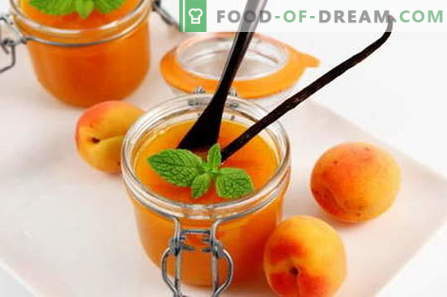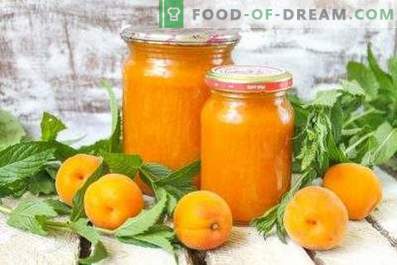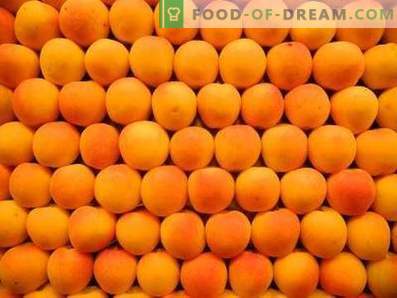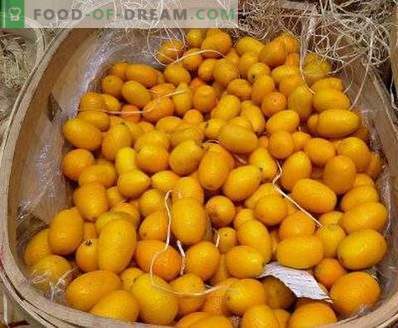
Apricot Jam - General Description
Apricot trees were bred in Southeast Asia and soon spread to many countries. This plant was especially popular in Armenia, which is probably why apricot is called Prúnus armeniáca in Latin. There are about 20 varieties of this fruit in the world, the sweetest of which come from Central Asia called apricot. There are wild apricots growing in Moldova and in the North Caucasus, they are called perches.
But no matter what kind of apricot is discussed, you should definitely mention the extraordinary value of this product. It contains a lot of vitamin C, folic acid, carotene (provitamin A), tartaric acid, trace elements (potassium, magnesium, forfor, iron, iodine), flavonoids, sugars, tannins, pectin and much more. Apricots are very useful with a lack of vitamins, anemia and cardiovascular diseases.
Unfortunately, the Russian climate does not allow eating fresh apricots all year round, but you can make jam from them, which will be equally tasty and healthy. For jam, depending on the recipe, you can use both ripe and slightly immature fruits. You can cook it only with apricots, and you can combine different fruits. The texture of the finished delicacy can also be different, in addition to the traditional jam, it can be jams or jams.
Apricot jam - cooking utensils
For cooking you will need enamelware. Its volume is selected at the rate of about 1.5 liters per 1 kg of fresh fruit. It is better if the saucepan is wide and low, then mixing the jam in the cooking process will be easier. Glass jars are used to store the jam, which must be sterilized beforehand. To do this, the pre-washed jars are placed in a large container with water and boiled for a few minutes. To get cans of boiling water and not burn yourself, it is better to stock up with special tongs. The size of the container is determined by the appetites of your household. It is better not to store a opened jar for a long time, that is, the less jam you can eat for a couple of days, the smaller the container should be. As for the covers, you can use metal on the screw, glass, plastic, or you can simply close the jar with parchment and tie it with string.
Apricot jam - preparation of fruits
For jam, you can use any kind of apricots, including the semi-wild zherdeli. Do not use overripe fruit. Apricots are boiled either as a whole or as halves, after separating the seeds. Some housewives only slightly cut the fruit, so that after the extraction of the bone the fruit was almost intact. It mainly depends on the size of the fruit and individual preferences. Sometimes kernels extracted from seeds are put into jam, but with such recipes one has to be careful, because sometimes kernels can cause unpleasant consequences, including poisoning.
Apricot jam (option 1)
For the preparation of this jam is better to use slightly unripe fruit. They should be thoroughly washed, dried on a towel, free of stones and put in an enamel container. Next, prepare a syrup of sugar and water in the ratio of 4: 1 (that is, 200 ml of water will require 800 grams of sugar). Granulated sugar is poured with water in a separate saucepan, and with continuous stirring, the mixture is brought to a boil. Next, prepared apricots are poured with syrup at the rate of 1 liter per 1 kg of fruit. After that, the container should be covered with a towel and left in a cool place for 10-12 hours (for example, at night). Then the syrup is poured into a saucepan, again brought to a boil, the fruit is poured over it and again left at the same time. The process should be repeated 3-4 times, then the fruit in the finished jam will remain whole and appetizing in appearance. After all this, put the jam on a slow fire and boil for 35-40 minutes. Then it is poured over prepared cans, tightly closed with lids and put in a cool place.
Apricot jam (option 2)
For those who do not have time for repeated manipulations with syrup, there is another recipe. Apricots should be washed, dried and freed from the seed. Next, they need to fall asleep sugar in the ratio of 1 kg of sand to 1 kg of fruit. It is necessary to wait until the fruit will give the juice, which will cover them completely. After that, the container is placed on a slow fire, and the jam is brought to a boil with constant stirring. As soon as the contents of the pan boil, remove it from the heat and cool to room temperature. After that, bring to a boil again, repeating this procedure 2-3 times. It also contributes to better preservation of the fruit in the finished jam.
Apricot jam with oranges
For those who like a pleasant sour taste in dishes, the recipe of apricot jam with oranges is suitable. This dish requires 1 kg of oranges and 2 kg of sugar per 4 kg of apricots. Oranges should be cut into half rings, and the apricots should be divided into halves, removing the bones. Next, the fruit is laid out in an enamel bowl and covered with sugar. After 2-3 hours, put the dishes on a slow fire and bring to a boil. Cool and repeat the process. Then spread in banks, tightly closed and put in a cool place.
Apricot Jam
For this dish, you need to take very ripe fruits, wash them, dry them, separate the stones and mince them. You can also grind in a blender, mixer or food processor. Next, the mashed potatoes should be mixed with sugar at the rate of 0.5 kg of sugar per 1 kg of fruit. Cook jam on high heat with constant vigorous stirring for 12-15 minutes. Banks are laid out hot, wrapped in heat and kept to cool. Keep ready-made jam in a cool place.
Apricot jam - useful tips from experienced chefs
Tip 1. For jam with bones suitable only large-sized fruit with nucleoli that have a pleasant sweet taste. If the nucleolus is bitter or acidic, it is not recommended to use it.
Tip 2. To keep the apricot whole, the bone can be removed not by cutting the fruit, but simply pushing it out with a wooden stick. An indispensable condition for such a decision - apricot must be very ripe.
Tip 3. For better preservation, you can add a little citric acid in the jam (about 1/2 teaspoon per 2 kg of jam).













